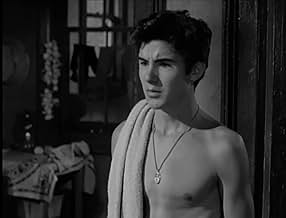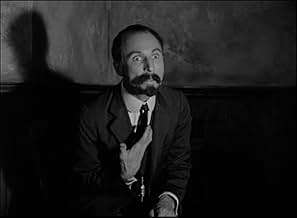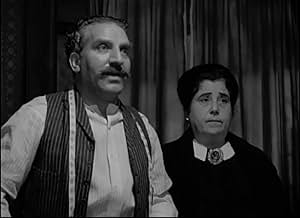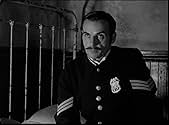IMDb-BEWERTUNG
6,4/10
1024
IHRE BEWERTUNG
Füge eine Handlung in deiner Sprache hinzuBack in NYC from Italy, Johnny Columbo seeks revenge on his father's killers, the Black Hand. Love and friendship with a police officer make him consider lawful alternatives to vengeance.Back in NYC from Italy, Johnny Columbo seeks revenge on his father's killers, the Black Hand. Love and friendship with a police officer make him consider lawful alternatives to vengeance.Back in NYC from Italy, Johnny Columbo seeks revenge on his father's killers, the Black Hand. Love and friendship with a police officer make him consider lawful alternatives to vengeance.
- Regie
- Drehbuch
- Hauptbesetzung
Eleonora von Mendelssohn
- Maria Columbo
- (as Eleonora Mendelssohn)
Empfohlene Bewertungen
After his father is murdered for standing up to the mob Johnny Columbo swears to avenge his death. Well entrenched in Little Italy the Mafia uses violence and intimidation to keep the community in its grip and Columbo finds it difficult at first to get assistance in breaking the code of silence that solidify's their grip. When he enlists the help of detective Louis Lorelli things begin to happen and the mob responds harshly.
Gene Kelly in an off type role as Johnny is a slight stretch (it begs for Richard Conti) but convincing enough. It is J. Carroll Naish as intrepid detective Lorelli though that runs away with the film. It's nice to see J. center stage and noble given his career as a venal and craven weakling in many of his films hanging on the edge of scenes, ready to pounce on someone's misfortune.
Workman like director Richard Thorpe more than once allows his scenes to drag in spots but cinematographer Paul Vogels excellent camera work fills the suspense lapses with excellently lit exteriors and some nice subtle tracking work. There are Lang like moments as well with Thorpe eschewing suspense music in favor of silence and ambient noise to heighten scenes but his poor pacing and moments of incredulity prevent the film from reaching full potential.
There is certainly more ugly truth to be found in the film Black Hand that deals with the same topic of the Mafia as the more sophisticated violently romantic Godfather films. Pale in comparison to the production values, vaunted cast and and directing styles of the saga it still delivers moments that rival.
Gene Kelly in an off type role as Johnny is a slight stretch (it begs for Richard Conti) but convincing enough. It is J. Carroll Naish as intrepid detective Lorelli though that runs away with the film. It's nice to see J. center stage and noble given his career as a venal and craven weakling in many of his films hanging on the edge of scenes, ready to pounce on someone's misfortune.
Workman like director Richard Thorpe more than once allows his scenes to drag in spots but cinematographer Paul Vogels excellent camera work fills the suspense lapses with excellently lit exteriors and some nice subtle tracking work. There are Lang like moments as well with Thorpe eschewing suspense music in favor of silence and ambient noise to heighten scenes but his poor pacing and moments of incredulity prevent the film from reaching full potential.
There is certainly more ugly truth to be found in the film Black Hand that deals with the same topic of the Mafia as the more sophisticated violently romantic Godfather films. Pale in comparison to the production values, vaunted cast and and directing styles of the saga it still delivers moments that rival.
Plot--As a youngster Johnny Columbo vows to crack the criminal organization in New York's Little Italy, the Black Hand, after they've murdered his father. As an adult he seeks to carry out his pledge among the teeming streets, where people are mostly too intimidated to help out. Eventually, he allies with the fearless Louis Lorelli. But will that be enough.
It's a well-produced crime drama from MGM. I suspect the film was approved under the general aegis of Dore Schary who was replacing Louis B. Mayer as studio head. Under Mayer the studio typically turned out sunny escapism that came to define Hollywood as the Dream Factory. But the sunny themes of Andy Hardy were out of synch with a traumatized post-war audience, so studio adjustments such as Schary's darker vision was needed. Black Hand typifies the noirish themes that came to dominate the period that Schary's former studio RKO specialized in.
Looks like actor Kelly was also hoping to expand his range into the new period. I had some difficulty viewing him as an Italian immigrant, but he manages the lingo smoothly enough even though I kept expecting a soft shoe at any moment. The movie itself creates some suspense even though director Thorpe films in impersonal style. Unfortunately, that minimizes the many dramatic highlights that more close-ups and edgier acting would have underscored. Nonetheless, the shabby settings and shadowy lighting impart an appropriate mood. Columbo's moral predicament at the end is a poignant one, a culmination of the shadowy mood.
Overall, the result fails to give enough bite to the drama implicit in the material. My guess is Schary should have brought some of RKO's crime specialists with him.
It's a well-produced crime drama from MGM. I suspect the film was approved under the general aegis of Dore Schary who was replacing Louis B. Mayer as studio head. Under Mayer the studio typically turned out sunny escapism that came to define Hollywood as the Dream Factory. But the sunny themes of Andy Hardy were out of synch with a traumatized post-war audience, so studio adjustments such as Schary's darker vision was needed. Black Hand typifies the noirish themes that came to dominate the period that Schary's former studio RKO specialized in.
Looks like actor Kelly was also hoping to expand his range into the new period. I had some difficulty viewing him as an Italian immigrant, but he manages the lingo smoothly enough even though I kept expecting a soft shoe at any moment. The movie itself creates some suspense even though director Thorpe films in impersonal style. Unfortunately, that minimizes the many dramatic highlights that more close-ups and edgier acting would have underscored. Nonetheless, the shabby settings and shadowy lighting impart an appropriate mood. Columbo's moral predicament at the end is a poignant one, a culmination of the shadowy mood.
Overall, the result fails to give enough bite to the drama implicit in the material. My guess is Schary should have brought some of RKO's crime specialists with him.
Gene Kelly was a perfectly good dramatic actor(e.g Inherit the Wind,Seagulls Over Sorrento)but it is not good casting asking him to play an earnest young Italian American intent on avenging the death of his father at the hands of New York gang the Black Hand He tries the legal route,aided by a veteran Italian-American cop,played in another bizarre piece of casting by J Carroll Naish,before resorting to a physical confrontation with the bad guys The movie moves briskly and will satisfy those looking for an afternoon's diversion in front of the TV but the acting does not quite pass muster and the bad guys never seem all thar much of a threat Good direction though with some well handled action scenes
It doesn't make a good impression. It's in black and white, involves Gene Kelly in a strictly dramatic role, has low production values, and is rarely shown and never publicized. All the trappings of a B feature when movie theaters still showed double bills.
Yet it's interesting, for three main reasons. One is that the story itself simply isn't too bad. Unlike many of the Godfather-type epics, Italian immigrant life isn't romanticized. The settings are grungy. Families don't live in secluded splendor. If the plot isn't nearly as nuanced as more modern stories on the subject, neither does it falsify the nature of criminal groups. There are clearly good guys here, and clearly bad guys, and a couple of guys squeezed in the middle.
Two questions are raised that have little to do with the Black Hand. Few of the principal actors are Italian. Does it matter? Kelly, curly haired and wearing dark make up, looks the part, although he sounds like a Mid-Westerner rather than an Italian immigrant to New York. (He pronounces his Italian correctly, though.) J. Carrol Naish, an Irishman from New York, is also made to look swarthy and gives what is for him a modulated performance. The man specialized in ethnic universality. He played Arabs, Asiatic Indians, lots of Italians, and God know what else, except an Irishman. Like Lawrence Olivier, he had only one accent that seemed to fit all of his parts. Some years ago, Vanessa Redgrave, a virulent pro-Palestinian, played a Jewish violinist in a pretty decent TV movie -- "Playing for Time," I think was the title -- about survival in Theresenstadt. Whew! What a brouhaha! Imagine an anti-Zionist playing a Jew in a concentration camp! Before that, Freddie Prinz came in for a blistering because he played a Mexicano in "Chico and the Man," a TV series, and Prinz was half Hungarian and half Puerto Rican. Again, it seems to matter, but should it? Doesn't the essence of acting involve playing the part of someone else? Unless the portrayal is so far off the mark that it works only as parody, why should it matter to us? Reduced to the absurd, the argument would have us never playing anyone other than ourselves. The same logic would have us object to every performance on screen or stage, because the actors are pretending to be something that -- genetically and culturally -- they are not.
The second question, and the third thing about the movie that I found impressive, had to do with the sets. The production is studio bound. Large scale location shooting was only beginning in 1949. The sets are clearly artificial. But, although not as convincing as on-location shooting, the production is at least as suggestive, seeming a bit stylized and stylized in the right direction. Turn-of-the-century New York City poverty has rarely been so well captured. The head of the local Black Hand is arrested while taking a bath. He is in his cellar. (It's a definite "cellar," not a "basement"!) There is a single naked overhead light. The cellar walls seem made of large bricks hastily thrown together. The man is naked in a bathtub that has no running water. (He undoubtedly filled it with water from kettles warmed on the top of a coal burning range in the upstairs kitchen.) A goat stands placidly next to the tub, ignoring the intrusion of the cops. Now THAT is production design. Studio sets can be taken even further and still be effective. A scene in "Mystery of the Wax Museum" or "Horrors of same" has Phyllis Kirk being chased through turn-of-the-century New York streets by a deformed and murderous madman. The streets through which she runs and he shuffles bear the same resemblance to real streets that a schematic diagram does to the inside of a TV set. The apartment fronts look made of thin plywood. The windows -- all equally lighted with bland yellow -- are of identical size and all have their shades drawn, like glowing but blank and impenetrable eyes, suggesting there is no succor for the heroine behind any of them, only thin buttresses propping up the false fronts and a couple of lights strung by the grip. And of course, there are no pedestrians, there is no garbage in the gutters or the streets, let alone garbage cans, no vehicles, no nothing except those surrealistically empty streets. "The Black Hand" doesn't go this far, but is an effective suspension of realism and stylization. The scenes in "Naples" are almost overboard. The night-time streets of Italy are well enough done but Naish eats in a Neapolitan restaurant with a view overlooking a patently false bay. It's the kind of "staged authenticity" that the sociologist Dean MacCannell described. All that was needed, besides that blow up, would be a couple of fish nets and phony salamis and provolones hanging from the walls.
There are three kinds of phoniness here: (1) the plot that pits good against evil; (2) the substitution of non-Italian actors for Italian characters; and (3) the use of studio sound stages as substitutes for real locations. None of it matters. It's not a bad flick. Not very good -- no one could argue that -- but simply not bad. I enjoyed it anyway. I mean, in a way, its phoniness is emblematic of our own realities. Are you really everything you claim to be?
Yet it's interesting, for three main reasons. One is that the story itself simply isn't too bad. Unlike many of the Godfather-type epics, Italian immigrant life isn't romanticized. The settings are grungy. Families don't live in secluded splendor. If the plot isn't nearly as nuanced as more modern stories on the subject, neither does it falsify the nature of criminal groups. There are clearly good guys here, and clearly bad guys, and a couple of guys squeezed in the middle.
Two questions are raised that have little to do with the Black Hand. Few of the principal actors are Italian. Does it matter? Kelly, curly haired and wearing dark make up, looks the part, although he sounds like a Mid-Westerner rather than an Italian immigrant to New York. (He pronounces his Italian correctly, though.) J. Carrol Naish, an Irishman from New York, is also made to look swarthy and gives what is for him a modulated performance. The man specialized in ethnic universality. He played Arabs, Asiatic Indians, lots of Italians, and God know what else, except an Irishman. Like Lawrence Olivier, he had only one accent that seemed to fit all of his parts. Some years ago, Vanessa Redgrave, a virulent pro-Palestinian, played a Jewish violinist in a pretty decent TV movie -- "Playing for Time," I think was the title -- about survival in Theresenstadt. Whew! What a brouhaha! Imagine an anti-Zionist playing a Jew in a concentration camp! Before that, Freddie Prinz came in for a blistering because he played a Mexicano in "Chico and the Man," a TV series, and Prinz was half Hungarian and half Puerto Rican. Again, it seems to matter, but should it? Doesn't the essence of acting involve playing the part of someone else? Unless the portrayal is so far off the mark that it works only as parody, why should it matter to us? Reduced to the absurd, the argument would have us never playing anyone other than ourselves. The same logic would have us object to every performance on screen or stage, because the actors are pretending to be something that -- genetically and culturally -- they are not.
The second question, and the third thing about the movie that I found impressive, had to do with the sets. The production is studio bound. Large scale location shooting was only beginning in 1949. The sets are clearly artificial. But, although not as convincing as on-location shooting, the production is at least as suggestive, seeming a bit stylized and stylized in the right direction. Turn-of-the-century New York City poverty has rarely been so well captured. The head of the local Black Hand is arrested while taking a bath. He is in his cellar. (It's a definite "cellar," not a "basement"!) There is a single naked overhead light. The cellar walls seem made of large bricks hastily thrown together. The man is naked in a bathtub that has no running water. (He undoubtedly filled it with water from kettles warmed on the top of a coal burning range in the upstairs kitchen.) A goat stands placidly next to the tub, ignoring the intrusion of the cops. Now THAT is production design. Studio sets can be taken even further and still be effective. A scene in "Mystery of the Wax Museum" or "Horrors of same" has Phyllis Kirk being chased through turn-of-the-century New York streets by a deformed and murderous madman. The streets through which she runs and he shuffles bear the same resemblance to real streets that a schematic diagram does to the inside of a TV set. The apartment fronts look made of thin plywood. The windows -- all equally lighted with bland yellow -- are of identical size and all have their shades drawn, like glowing but blank and impenetrable eyes, suggesting there is no succor for the heroine behind any of them, only thin buttresses propping up the false fronts and a couple of lights strung by the grip. And of course, there are no pedestrians, there is no garbage in the gutters or the streets, let alone garbage cans, no vehicles, no nothing except those surrealistically empty streets. "The Black Hand" doesn't go this far, but is an effective suspension of realism and stylization. The scenes in "Naples" are almost overboard. The night-time streets of Italy are well enough done but Naish eats in a Neapolitan restaurant with a view overlooking a patently false bay. It's the kind of "staged authenticity" that the sociologist Dean MacCannell described. All that was needed, besides that blow up, would be a couple of fish nets and phony salamis and provolones hanging from the walls.
There are three kinds of phoniness here: (1) the plot that pits good against evil; (2) the substitution of non-Italian actors for Italian characters; and (3) the use of studio sound stages as substitutes for real locations. None of it matters. It's not a bad flick. Not very good -- no one could argue that -- but simply not bad. I enjoyed it anyway. I mean, in a way, its phoniness is emblematic of our own realities. Are you really everything you claim to be?
Although basically an Irishman with Irish parents, Gene Kelly succeeds very well in making a convincing Italian character. It is a great story in which Kelly gets plenty of opportunities to excel in his acrobatics (bur no dancing here!) as he generally insisted on doing his own stunts. Little Italy in New York, in which more Italians lived than in Rome around 1900, is very well recreated with excellent cinematography and photography and comes alive, in all its primitive conditions and circumstances but with the mob no less vicious and insidious than in later Godfather days; and the thriller created is as good a match as any to later New York gangster films. Teresa Celli is even more convincing as the Italian lady of the film, and all other characters are also absolutely right, especially J. Carrol Laish as the intrepid policeman ending up a martyr for not being too careful. The music by Alberto Colombo is also perfect, but I think the prize goes to Paul Vogel for the almost expressive photography.
Wusstest du schon
- WissenswertesThis was originally set up as a Robert Taylor vehicle.
- Alternative Versionenoriginal story about Lt. Petrosino,real NYC police officer, remade as Pay or Die with Ernest Borgnine
Top-Auswahl
Melde dich zum Bewerten an und greife auf die Watchlist für personalisierte Empfehlungen zu.
- How long is Black Hand?Powered by Alexa
Details
- Erscheinungsdatum
- Herkunftsland
- Sprachen
- Auch bekannt als
- La Mano Negra
- Drehorte
- Produktionsfirma
- Weitere beteiligte Unternehmen bei IMDbPro anzeigen
- Laufzeit
- 1 Std. 32 Min.(92 min)
- Farbe
- Seitenverhältnis
- 1.37 : 1
Zu dieser Seite beitragen
Bearbeitung vorschlagen oder fehlenden Inhalt hinzufügen


















